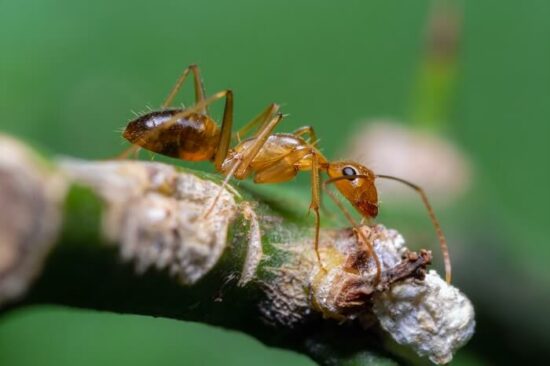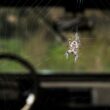Trying to figure out how to get rid of crazy ants can seem impossible at times. These little insects are surprisingly unpredictable and persistent!
This guide will teach you how to get rid of crazy ants, the best ways to kill them, and cover some tips on preventing them from coming back.
Table of contents
What Are Crazy Ants?
Named for their erratic, disorganized movements, crazy ants are invasive species of ants that were first discovered in the United States in 2002. Originally detected in Texas, these pests have since spread to other Gulf Coast states, including Louisiana, Mississippi, Alabama and Florida. Because crazy ants are so new to North America, they have no known natural predators on the continent.
There are many species of crazy ants, all much smaller than other ants at only around one-eighth inch long and all covered with coarse hair. Their mandibles are very long in proportion to their bodies, and there’s only one node between their thorax and abdomen. The distinctive legs are also relatively long in proportion to their bodies. Both sexes have wings, but the males seldom use theirs to fly and the females shed theirs after mating.
- Kills common household ants including acrobat, crazy, ghost, little black, odorous house, pavement, and other sweet-eating ants
- As worker ants discover the bait, they share it with the rest of the colony to eliminate them all
- You should see a significant decrease in the number of ants visiting the bait stations within just a few days
- Place stations near areas where you’ve seen ant activity
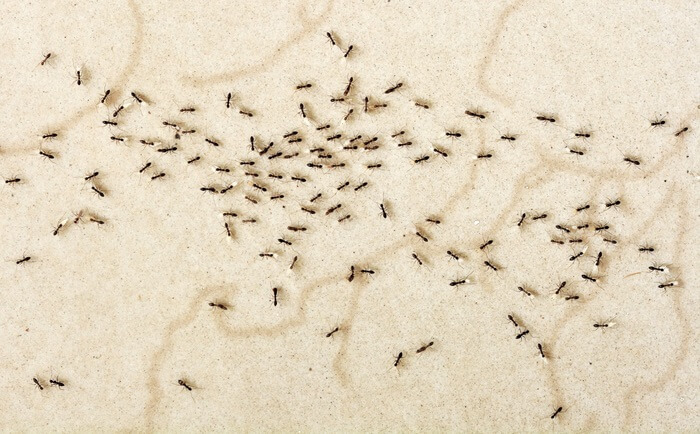
First seen in Houston in 2002 and still mostly found in Texas, the tawny crazy ant (or Nylanderia fulva) was formerly known as the Raspberry crazy ant. It was named after its discoverer, Thomas Raspberry. The tawny crazy ant can also be found in other Southern states, some Midwestern states and in Arizona, California and Hawaii.
Commonly known as the longhorn crazy ant, the black crazy ant, or Paratrechina longicornis, the crazy ant is dark brown or grayish black. Sometimes you’ll even see some with a touch of blue! Most common in Florida and other Gulf Coast states including South Carolina, Georgia, Alabama, Mississippi, Louisiana and Texas, this ant can also be found in isolated areas all throughout the United States.
Quick Tip: Worker longhorn crazy ants feature extremely long, 12-segmented antennae with no club. The antennae actually resemble the horns on longhorn cattle, so it’s no wonder the ant shares that name!
Besides its erratic behavior, the black crazy ant is notorious for its attraction to electrical and computer equipment. When they’re electrocuted, the black crazy ants emit a pheromone to call their ant friends for help. As a result, the rescue ants are themselves electrocuted. They also emit more pheromones which attract more ants. And the cycle continues.
The massive number of electrocuted dead ants can result in substantial damage to electrical systems. In fact, the total amount of damage black ants cause can actually reach $146 million each year! That’s why getting ants out of electronics is so important.
A relative of the tawny ant, the Caribbean crazy ant, formerly known as Nylanderia pubens, is a golden-brown or reddish-brown ant that lives primarily in Florida and Texas but can also be found in other Gulf Coast states.
Other species of crazy ants include the yellow crazy ant, or Anoplolepis gracilipes, that’s native to Southeast Asia and also known as the Maldive ant and the Brazilian crazy ant.
Why Do Crazy Ants End Up In Your Home?
Crazy ants will travel long distances in search of food. Worker ants are also omnivorous and will eat everything from other insects (dead or alive), to grease, to seeds, to liquids, to sweet foods such as produce, honey dew and honey.
- Kills common household ants including acrobat, crazy, ghost, little black, odorous house, pavement, and other sweet-eating ants
- As worker ants discover the bait, they share it with the rest of the colony to eliminate them all
- You should see a significant decrease in the number of ants visiting the bait stations within just a few days
- Place stations near areas where you’ve seen ant activity
These insects are especially attracted to kitchens and pantries. Like all ants, crazy ants are also attracted to high humidity, so they might find your bathroom to be an appealing place to invade as well. Crazy ants also prefer warm places to hide, which is another reason they’ll find your home attractive (especially when the weather turns cooler in the fall). They can enter your house through a cracked foundation, under doors or around windows and through cracks in walls and in furniture.
As we’ve seen, crazy ants (especially black crazy ants) are attracted to electrical equipment. This includes electrical outlets and appliances, HVAC units and window air conditioning units.
The Importance Of Getting Rid Of Crazy Ants Quickly
We’ve gone over how some crazy ants can spread in your home and even damage electrical equipment, which makes an infestation a potentially serious situation. This is why it’s so important to get rid of crazy ants.
Because crazy ants reproduce so rapidly, their numbers can increase enough to even displace native ants. If you want to control them and keep your home free of infestations, it’s important to act fast.
Quick Tip: To make things even trickier, crazy ants often live both outdoors and indoors and have erratic movement patterns. This poses an additional challenge, which is why homeowners often get frustrated when trying to get rid of crazy ants.
How To Get Rid Of Crazy Ants
Before you learn how to get rid of crazy ants, you’ll need to make sure it’s the species of ant that has invaded your property. Once you’ve properly identified the ants, you must work as quickly as possible to get rid of them before their numbers increase and get out of control.
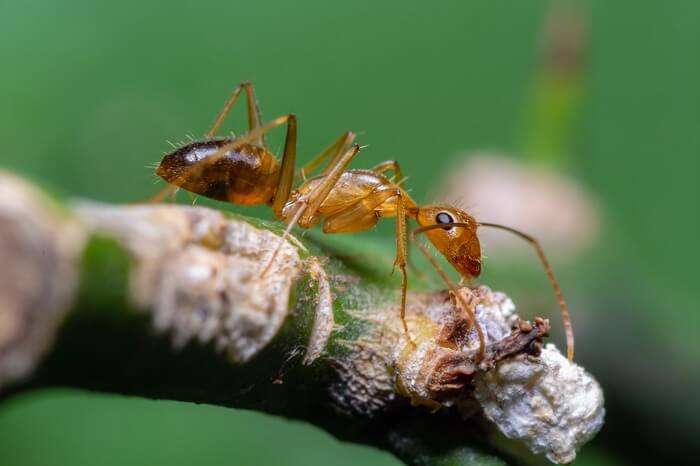
It’s likely that there are still some crazy ants outside if they’ve already invaded your house. This is because they often go indoors in search of food or a warmer habitat and then return outdoors after they’ve found food or the weather outside has turned warmer.
Of course, you’ll first want to get rid of crazy ants indoors and then move on to destroying their mounds and nests outside. In addition, if you have a habit of eating in your car, don’t forget that crazy ants may have also invaded your vehicle (getting rid of ants in your car requires a specialized approach).
Here are some steps you can take to kill and get rid of crazy ants.
1. Inspect & Locate
Once you’ve detected them in your home, the most difficult step in getting rid of crazy ants is locating their entry points and outdoor colonies. To find their colonies, be sure to search under rocks, stumps, rotten wood and firewood.
Because crazy ants wander so erratically, it’s hard to find their trails. To encourage them to form a straight trail, you can offer them a protein and sweet bait combo, such as jelly or honey plus peanut butter or tuna. Here is the bait method you can use to get the ants to form a straight trail.
- Place large dabs of both sweet and protein foods next to each other on a piece of aluminum foil or on a note card.
- Place the foil or card on the floor in a corner that’s closest to the area where ants are most prevalent. If ants abound in more than one area, put foil or cards in those places, as well.
Quick Tip: Allow a couple hours for the worker crazy ants to find the food and form a straight trail from their colony to the food source and back to the colony.
2. Spray & Dust
Sprays are recommended for outdoor use and are an especially effective crazy ant killer when you can target visible ants and nests.
To treat the infestation outdoors, spray a non-repellent insecticide around the perimeter of your home. Because the crazy ants can’t detect the insecticide, they’ll walk right through it and spread it to other ants when they groom one another. These ants, in turn, ingest the insecticide and pass it on to other ants that they feed through regurgitation. Repeat the process every 1 1/2 to 2 months to stay on top of things.
You can use the insecticide Dominion 2L on ant trails or other areas where ants might frequent, such as flower beds, shrubs or ornamental plants. The synthetic pyrethroid cypermethrin is contained in insecticides such as Cynoff WP and Demon WP. These products are effective at killing crazy ants for longer periods of time than are some other insecticides.
Dusts can be effective on indoor colonies. To use a dust product, cover the nest with the dust and then carefully puff more dust into the entrance of the nest, taking special caution as to not disturb it. You can also dust inside the cracks, crevices and gaps where you notice ant activity. If you haven’t gotten rid of all the crazy ants after a few days, you can repeat the process.
3. Set Out Crazy Ant Bait
Although not the most dependable method for getting rid of crazy ants, ant bait can actually be the most effective in the long term.
- Kills common household ants including acrobat, crazy, ghost, little black, odorous house, pavement, and other sweet-eating ants
- As worker ants discover the bait, they share it with the rest of the colony to eliminate them all
- You should see a significant decrease in the number of ants visiting the bait stations within just a few days
- Place stations near areas where you’ve seen ant activity
Quick Tip: It’s best not to use a bait with a spray or a dust, as the latter two will only contaminate the bait and lead to the ants avoiding it altogether.
Relatively safe to use both indoors and out, baits are easy to apply and effective in killing entire colonies of crazy ants. Worker ants ingest the bait and take it back to the nest to feed the larvae and share it with other crazy ants in the colony.
Baits such as InVict Blitz and InVict Xpress with imidacloprid work on the ants’ protein cycle, while Advion Ant Bait Gel works on their sugar cycles. Outdoors, you can apply the InVict baits around the perimeter of your home and on the lawn. Indoors, apply them in cracks and crevices. You can use the InVict baits outdoors along with non-repellent insecticides (just wait until the insecticide has dried before applying the bait).
Granule ant baits are an eco- friendly type of pest control that you can use outdoors. Extremely easy to apply, you just spread the granules on the lawn or any other area where ants might frequent. The pests will simply pull the granules to their nests and expose the entire colony!
It’s a good idea to combine at least a couple different baits to provide a variety of choices in case the crazy ants are picky eaters.
Containing an active ingredient of borax, Advance Liquid Ant Bait is a balanced formula of sugar and water and is designed to completely kill whole colonies of crazy ants. The protein-based Maxforce FC Ant Bait Stations feature fipronil as an active ingredient and work quickly, reducing the ant population by as much as 90 percent within just four days.
Quick Tip: If you want to make your own recipe, here’s a guide on how to kill ants with borax that gives you some more options.
Areas in Your House Where You Can Typically Find Crazy Ants
Crazy ants seek warm places to live, and that’s why they tend to invade homes when the weather begins to cool down in the fall.
There are several reasons why one of the crazy ants’ favorite rooms to infest is the kitchen (they might even be found in your kitchen sink). With the presence of stoves and ovens, kitchens offer warmth. There’s also plenty of food around. In addition, the kitchen contains numerous attractive electrical outlets and appliances where the ants can hide. Finally, the crazy ants can find even more hiding places behind the counters and in cupboards!
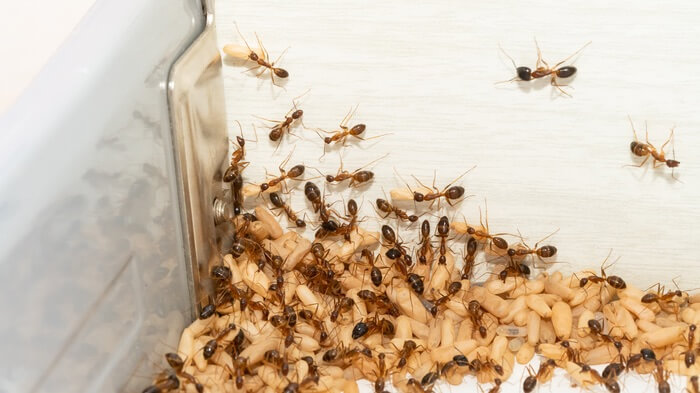
Crazy ants also look for humid places to live, and the bathroom is an ideal room for this purpose. Ants will hide wherever there may be cracked tiles and under tubs, sinks and toilets. They’ll hide behind washers and dryers too. This unpredictability is why it’s important to assess the entire situation when trying to get rid of crazy ants in your home.
How To Naturally Get Rid Of Crazy Ants
If you have children or pets, you might be hesitant to use pesticides or any other toxic product to get rid of crazy ants. Fortunately, there are some ways to get rid of crazy ants naturally as well.
One of the most popular and effective natural solutions is diatomaceous earth. Available in powder form, you can also combine it with sugar for better results. Easy to use, this method works well in areas where you find large groups of ants.
Quick Tip: Avoid using it with water though, since liquid decreases its potency.
Another natural method to get rid of crazy ants is a combination of vinegar and water. The vinegar repels ants by confusing their sense of smell. However, you will need to reapply it regularly.
Although not as effective on crazy ants as it is with other ant species, cotton balls soaked in a solution of 1 1/2 tablespoons of borax, 1/2 cup of sugar and a small amount of water can be effective. You just place the soaked cotton balls on the ant trails or anywhere else you notice activity. The crazy ants will carry the cotton balls back to their colony and spread the solution among the others.
Preventing Crazy Ants From Coming Back
By far the best method to avoid having to kill crazy ants is to simply prevent them from invading your home in the first place!
Just because you had a crazy ant infestation in your home doesn’t mean you’ve failed to keep your house clean. However, cleanliness is one of the most important steps you can take to prevent a crazy ant invasion. Practice good sanitation by immediately wiping up any food or drink spills, and keep food preparation and consumption in only one or two rooms. Remember, if you choose to eat in the living room or bedroom, the ants will follow those crumbs!
Leaky pipes or faucets can also attract ants simply because they contribute to a humid environment. Be sure to repair any plumbing to prevent this from happening.
When it comes to the outdoors, caulk cracks, crevices, and gaps in your home’s foundation. Take the time to weather strip around windows, doors, and baseboards indoors to seal off potential ant entryways there as well.
Quick Tip: Don’t forget to also seal off any outdoor openings into electrical, plumbing and HVAC and/or window air conditioning units.
Trim any tree branches, shrubbery or other vegetation away from the structure to prevent ants from using the foliage as a pathway into your home. Also remove stacked wood or lumber, stones, bricks, leaves, mulch, trash, and other material adjacent to your home where crazy ants could potentially hide.
To prevent crazy ants from infesting your car, keep the vehicle clean and especially free of food crumbs and particles. Once these insects have invaded a vehicle, they leave behind a pheromone trail for others to follow. To prevent further infestation, park the vehicle in a different place for a while to allow the pheromone scent to gradually leave.
If you’re unable to effectively get rid of crazy ants yourself and decide to hire a professional ant exterminator to tackle the job, they’ll help by suggesting steps you can take to prevent future infestations.
Do Crazy Ants Bite?
Yes, crazy ants do bite. However, the bite isn’t poisonous, and the mild pain the bite causes leaves after only a minute or so.
Also, most people don’t suffer an allergic reaction after they’re bitten. Unlike many other ant species, crazy ants don’t sting, so you don’t need to worry about that either.
Final Thoughts
Once you’ve learned how to get rid of crazy ants, the frustration of the process should fade away. While pesky, these insects are no match for a smart and consistent pest control strategy.
If you have any other questions about controlling these critters (or suggestions on crazy ant killers you like), we’re happy to listen. Just send us a message through the contact form on the site and we’ll be in touch!
